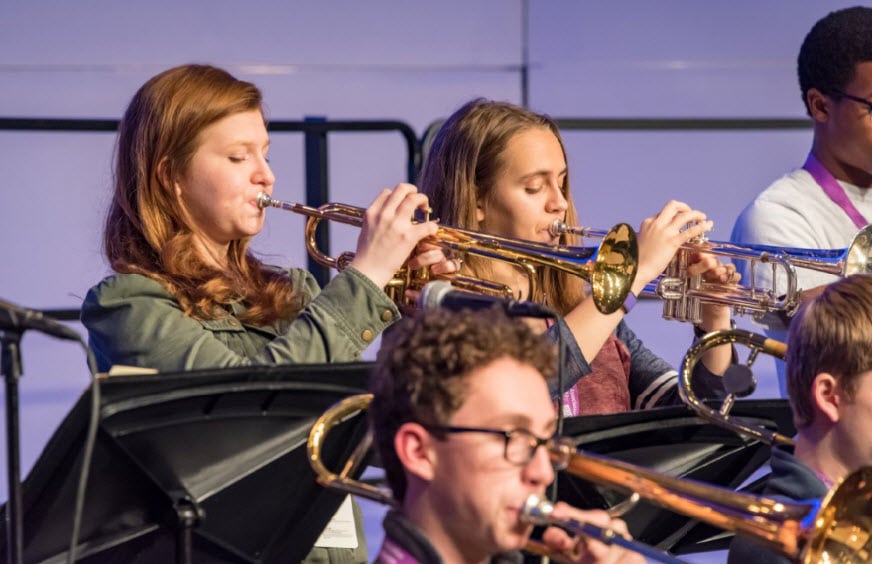/ News Posts / Envisioning and Articulating Your Program’s Future
Sharpen Your Vision
Envisioning and Articulating Your Program’s Future
By NAfME Member Lori Schwartz Reichl
This article was originally published in the October 2018 teacher edition of In Tune Magazine.
“Leadership is the capacity to translate vision into reality.” ~ Warren Bennis
With the excitement and exhaustion of the first weeks of school fading away, now is a critical time to evaluate the effectiveness of your music program’s vision. Is it still in focus? As the leader of your program, it is imperative that you communicate a vision to all involved for the improvement or maintenance of the program, success of each student, and preservation of your sanity. Did you effectively articulate the vision to your students, their families, your colleagues, the community, and all supporters? Are you wishing you would have considered another component or worded something differently? Are you effectively referencing the vision in your daily teaching, correspondences, and performances? Most importantly, are you passionately embodying the vision through activities both in an out of the school?

iStockphoto.com | jdillontoole
Building a superior music program, particularly one that contains performing ensembles, requires acknowledgement of specific components from its members and supporters. It is the primary job of the program’s director to communicate the plan through realistic means. In the spring of 2014, I was asked to serve as band director for the opening of a newly constructed school. Students enrolled in this new school came from 27 previous schools, due to school system redistricting, feeder placements, or family moves. My challenge was to funnel the varying experiences and preconceived ideas of these numerous students and their families into one newly organized, intentional vision. Before even stepping foot into the new school, my efforts required an abundance of preparation, passion, persistence, positivity, and pride. I aimed to create a dynamic vision for this new school as it would serve as the foundation for the program’s future. I wanted those involved in the program to visualize where it was headed before any music was performed.
In preparing to establish this new school’s music program, I spent time evaluating key components that I found beneficial in building the two previous band programs I had led. I carefully reviewed student expectations, rehearsal routines, program perceptions, administrative requests, and community support. I chose to create a vision that was brief and concise, embraced my distinct philosophy of teaching, would be supported by administration, and would motivate members. After writing several drafts of this vision and obtaining administrative approval, I settled on these words (with “band” easily replaced by chorus, orchestra, etc.):
Building a superior band program, requires the following from its members and supporters:
- An understanding that band is a commitment of time, money, and emotion, which will help children to develop a sense of responsibility, time management, and perseverance. Band is a group-performance class and all members are crucial to the overall success of the ensemble for every event. Attendance, preparation, and discipline will be daily expectations.
- The ability of each musician to commit to a daily and diligent practice routine both at home and school. Practicing must be treated like any other homework assignment.
- The kindness of families and supporters to willingly serve as volunteers for the program.
- The support of the community to recognize the massive impact music has on educating the whole child, while fostering a sense of pride and unity.
I placed this vision everywhere that seemed appropriate—in the band handbook, website, documents, bulletin boards, emails, etc. I prefaced this vision with the band’s motto: One Band. One Sound. One Family. (Reference my article, “A Motto for Success: The Surprising Benefits of Music Classroom Sloganeering” to discover ideas for creating an inspirational classroom motto.) The vision was well received. So much so, that a few years later I saw my vision posted on the website of a colleague—with no credit given. (Reference my article, “Embrace Your Uniqueness: Gaining Inspiration Without Plagiarizing” to review professional ways for utilizing the intellectual property of others.)
My vision includes significant words and phrases that often roll off my tongue with little thought or effort because they are at the core of my educational beliefs. I have observed that a benefit of this practice is that members and supporters begin using the same terminology when referencing the program; moreover, the administration supports instructional methods, colleagues value the program’s worth, parents appreciate organizational efforts, and students trust the expertise.
When creating your program’s vision, consider including some of the following program components:
- assessment
- commitment
- curriculum
- discipline
- expectation
- goal setting
- instruction
- motivation
- perception
- performance
- philosophy
- recruitment
- retainment
- support
- unity
- volunteerism
A vision gives purpose, provides passion, and offers direction. Without a vision, a program can appear one-dimensional, meaning only the current school year is in focus. The music program’s director and creator of the vision must think beyond the current school year and understand how previous, present, and prospective students, performances, and experiences have and will shape the program’s path. A promising future must be envisioned, articulated, and practiced daily.
About the author:

Photo: Richard Twigg Photography
Lori Schwartz Reichl actively serves as an adjudicator, author, clinician, conductor, instructor, and speaker. Lori is the author of the “Tools for Educators” series entitled “Key Changes: Refreshing Your Music Program” published for InTune Monthly Magazine’s Teacher’s Edition, where she provides resources to enhance the music classroom and rehearsal space. Her column has been transformed into a summer graduate course that she instructs through the University of the Arts. Lori’s articles are also featured each month as part of the National Association for Music Education Music in a Minuet blog. In addition, her publications frequently appear in the Maryland Music Educator Journal and The Woman Conductor Journal. Lori also serves as a journalist for Teaching Music magazine and writes program notes for composers. In Maryland, she serves as artistic and executive director of the Regional Repertory Wind Ensemble, coordinator of Howard County’s Secondary Solo & Ensemble Festival, conductor of the Howard County Middle School Honor Band, and the Maryland state chair for Women Band Directors International. Visit her at MakingKeyChanges.com.
Did this blog spur new ideas for your music program? Share them on Amplify! Interested in reprinting this article? Please review the reprint guidelines.
The National Association for Music Education (NAfME) provides a number of forums for the sharing of information and opinion, including blogs and postings on our website, articles and columns in our magazines and journals, and postings to our Amplify member portal. Unless specifically noted, the views expressed in these media do not necessarily represent the policy or views of the Association, its officers, or its employees.
Catherina Hurlburt, Marketing Communications Manager. September 10, 2019. © National Association for Music Education (NAfME.org)
Published Date
September 10, 2019
Category
- Ensembles
- Program Development
Copyright
September 10, 2019. © National Association for Music Education (NAfME.org)





